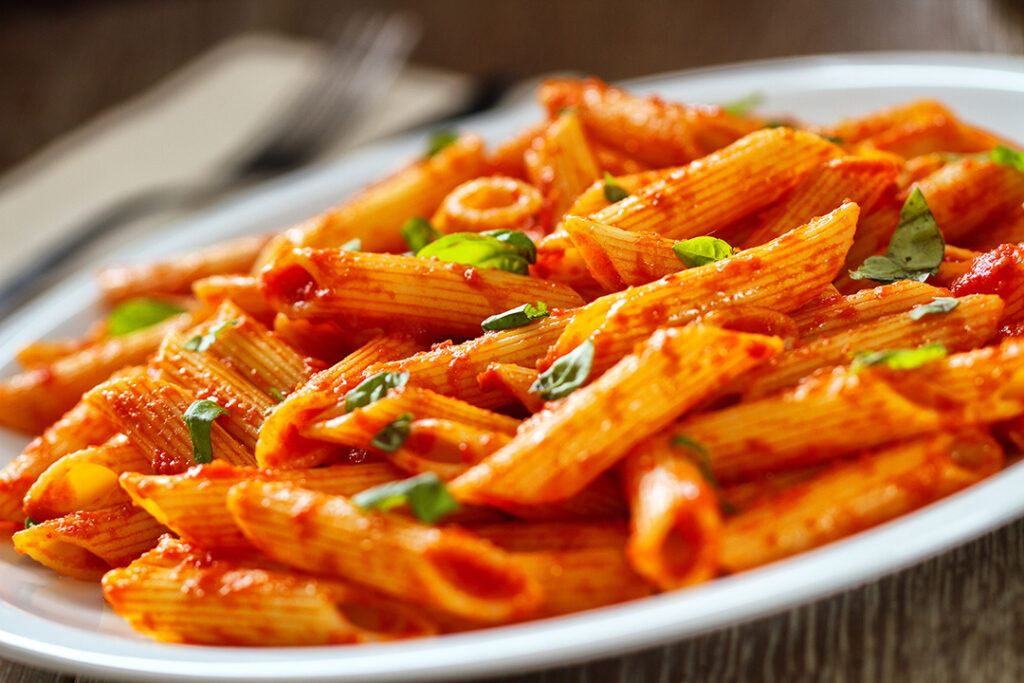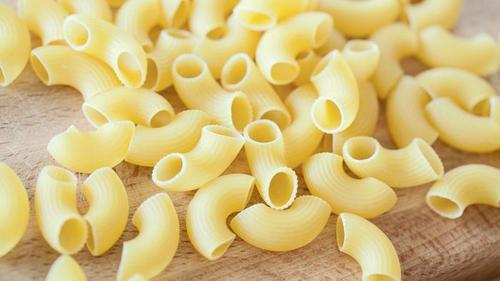What is Pasta?
A dish originally from Italy consisting of dough made from durum wheat and water, extruded or stamped into various shapes and typically cooked by baking or boiling water. Rice flour or legumes such as beans or lentils are sometimes used in place of wheat flour to yield a different taste and texture, or as a gluten-free alternative. Pasta is a staple food of Italian cuisine.
Pasta is formed into ribbons, cords, tubes, and various special shapes, all originally developed for specific characteristics, such as ability to retain heat or hold sauces. Doughs may be colored with spinach juice, producing green pasta; with beet juice, resulting in red types; and with eggs, adding bright yellow color. Eggs are frequently added to homemade pastas.
Pastas are divided into two broad categories: dried (pasta seccsa) and fresh (pasta fresca). Most dried pasta is produced commercially via an extrusion process, although it can be produced at home. Fresh pasta is traditionally produced by hand, sometimes with the aid of simple machines. Fresh pastas available in grocery stores are produced commercially by large-scale machines.
In commercial processing, the semolina mixed with warm water is kneaded into a smooth stiff dough and extruded. The dough, moved forward while it is being compacted and mixed, is forced through perforated plates, or dies, that form it into the desired shape.

What You Need To Know About Pasta
- A dish originally from Italy consisting of dough made from durum wheat and water, extruded or stamped into various shapes and typically cooked in boiling water.
- It comes in various shapes and sizes.
- Fresh pasta can either be boiled or baked to cook.
- Eggs may be used in the preparation of pasta.
- It is slightly less popular than macaroni due to the difficulties associated with its commercial production and transport to distant places.
- Pasta can be produced by hand (manually) or with the aid of simple machines.
- Dry pasta has a long shelf life while fresh pasta has a short shelf life.
- Pasta contains 131 calories per 100g.
- Fresh and dry pasta can both vary in their costs as they both use very different ingredients.
- Pasta is typically a popular dish in Italy.
Also Read: Difference Between Parsely And Coriander
What Is Macaroni?
Macaroni is a type of dry pasta that looks like narrow tubes. Although, it is an Italian cuisine, it is famous throughout the world. Made with durum wheat, macaroni is commonly cut in short lengths; curved macaroni may be referred to as elbow macaroni. Were it not for the shape and appearance, there would be no difference between pasta and macaroni which means that macaroni and pasta are basically the same. Although the basic components in the preparation of standard pasta and macaroni involve wheat and water, the preparation of pasta sometimes comprises the addition of eggs while macaroni does not involve the addition of eggs.
Some home machines can make macaroni shapes, but like most pasta, macaroni is usually made commercially by large-scale extrusion. The curved shape is created by different speeds of extrusion on opposite sides of the pasta tube as it comes out of the machine.

What You Need To Know About Macaroni
- Macaroni is a type of dry pasta in the shape of narrow tubes.
- It generally comes in specific C shaped narrow tubes.
- Macaroni has to be boiled first before cooking.
- Macaroni is prepared without eggs.
- Macaroni is more popular than pasta as it can be produced commercially and exported to different parts of the world.
- It is produced only by the use of machines due to its specific C shaped tube like structure.
- Macaroni is dried and removes the moisture content and therefore has a long shelf life.
- Macaroni contain 371 calories per 100g.
- Macaroni is cheap as it is commercially produced.
- Macaroni is popular in United States and other parts of the world.
Also Read: Difference Between Dinner And Supper
Difference Between Pasta And Macaroni In Tabular Form
| BASIS OF COMPARISON | PASTA | MACARONI |
| Description | Pasta is typically a noodle made from unleavened dough of durum wheat flour, mixed with water or eggs. | Macaroni is a type of dry pasta in the shape of narrow tubes. |
| Shape | Pasta comes in various shapes and sizes. | Macaroni has the shape of small bent hollow tubes. |
| Cooking | Fresh pasta can either be boiled or baked to cook. | Macaroni has to be boiled first before cooking. |
| Eggs | Eggs may be used in the preparation of pasta. | Macaroni is prepared without eggs. |
| Popularity | It is slightly less popular than macaroni due to the difficulties associated with its commercial production and transport to distant places. | Macaroni is more popular than pasta as it can be produced commercially and exported to different parts of the world. |
| Production | Pasta can be produced by hand (manually) or with the aid of simple machines. | It is produced only by the use of machines due to its specific C shaped tube like structure. |
| Shelf life | Dry pasta has a long shelf life while fresh pasta has a short shelf life. | Macaroni is dried and removes the moisture content and therefore has a long shelf life. |
| Calories | Pasta contains 131 calories per 100g. | Macaroni contain 371 calories per 100g. |
| Cost | Fresh and dry pasta can both vary in their costs as they both use very different ingredients. | Macaroni is cheap as it is commercially produced. |
| Country of Dominance | Pasta is typically a popular dish in Italy. | Macaroni is popular in United States and other parts of the world. |